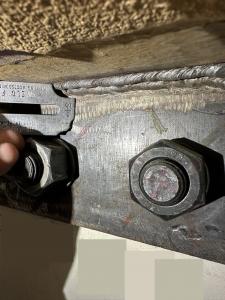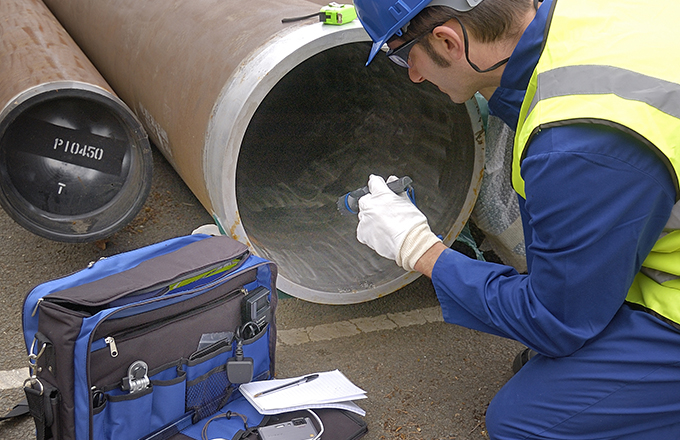Welding Inspection Racine: Making Sure Accuracy and Reliability in Every Weld
Welding Inspection Racine: Making Sure Accuracy and Reliability in Every Weld
Blog Article
Cutting-edge Approaches to Fillet Weld Inspection and Screening: Enhancing Weld High Quality and Compliance Specifications
In the realm of welding, the top quality and stability of fillet welds play an essential role in ensuring the architectural strength and reliability of numerous industrial parts. With the continuous drive for improved performance and compliance with rigorous requirements, the exploration of ingenious approaches to fillet weld examination and testing has actually become crucial.
Advanced Non-Destructive Testing Approaches
Using state-of-the-art innovations, progressed non-destructive testing approaches play an essential duty in guaranteeing the honesty and quality of fillet welds. These methods, such as phased variety ultrasonic testing (PAUT) and magnetic bit screening (MPT), deal comprehensive understandings into the weld's interior framework without creating any kind of damage to the product. PAUT, as an example, utilizes several ultrasonic components to inspect the weld from numerous angles, offering a thorough visualization of possible defects like lack of combination or splits.
Similarly, MPT works in detecting surface-breaking problems by using an electromagnetic field and iron fragments to the weld location. This approach is particularly beneficial for recognizing suspensions that might endanger the weld's strength. By employing these sophisticated non-destructive testing strategies, weld assessors can properly analyze the top quality of fillet welds, making certain compliance with sector standards and policies. The capacity to detect defects early not just improves weld high quality however likewise avoids costly rework or failures in architectural integrity, underlining the value of these cutting-edge screening strategies in welding evaluations.
Robotics and Automation in Examination
The assimilation of robotics and automation has changed the assessment process for fillet welds, boosting effectiveness and accuracy in high quality assessment. Robotics supply exact control and repeatability in examining welds, ensuring consistent and trustworthy results. Automated systems can be set to comply with particular examination paths, making certain complete coverage of welds and minimizing the risk of human error.
Robot inspection systems furnished with advanced sensors can identify and measure weld features with high accuracy, providing comprehensive information for analysis. These systems can determine issues such as fractures, absence of fusion, and porosity, enabling prompt restorative activities to be taken. Additionally, robotics and automation enable real-time information collection and analysis, giving immediate comments to drivers and assisting in quick decision-making procedures.
Furthermore, making use of robotics and automation in fillet weld evaluation boosts total productivity by minimizing examination times and enhancing examination throughput. By streamlining the examination process, makers can make sure weld top quality and conformity criteria are fulfilled efficiently, ultimately resulting in cost savings and enhanced product quality.
Using Expert System for Evaluation
Fabricated knowledge plays an essential function in enhancing the efficiency and accuracy of analysis in fillet weld examination processes. By taking advantage of the power of AI, examiners can streamline the analysis of weld quality and compliance criteria, bring about extra reliable and precise results. AI formulas can swiftly refine huge amounts of information from weld examinations, identifying flaws or variances that may be testing to identify with the naked eye. This advanced innovation makes it possible for real-time surveillance of weld high quality, permitting prompt restorative actions to be taken if any kind of problems are detected.
Furthermore, AI systems can gain from past examination data, continuously boosting their ability to determine possible defects and discrepancies in fillet welds. This flexible understanding capability improves the general top quality control process, decreasing the probability of human mistake and making certain that welds meet the required requirements. By incorporating expert system right into fillet weld evaluation, sectors can achieve greater degrees of effectiveness, uniformity, and conformity in their examination practices.
Portable Devices for On-Site Assessment
 Enhancing field evaluation performance, the fostering of mobile devices revolutionizes on-site assessment procedures for fillet welds. These devices supply adaptability and benefit, additional reading permitting inspectors to carry out comprehensive evaluations in different places, consisting of difficult or remote environments. Mobile devices such as ultrasonic testing gadgets, magnetic fragment evaluation equipment, and digital radiography systems provide real-time data and high-resolution imaging capabilities, enabling fast decision-making and instant comments on weld high quality.
Enhancing field evaluation performance, the fostering of mobile devices revolutionizes on-site assessment procedures for fillet welds. These devices supply adaptability and benefit, additional reading permitting inspectors to carry out comprehensive evaluations in different places, consisting of difficult or remote environments. Mobile devices such as ultrasonic testing gadgets, magnetic fragment evaluation equipment, and digital radiography systems provide real-time data and high-resolution imaging capabilities, enabling fast decision-making and instant comments on weld high quality.One considerable advantage of portable tools is their ability to streamline evaluation procedures, reducing downtime and boosting total performance. Inspectors can conveniently transport these devices to various job sites, getting rid of the requirement for carrying heavy equipment or parts to off-site facilities. Furthermore, the mobility of these tools advertises cost-effectiveness by decreasing transport expenses and accelerating examination timelines.
In addition, the use of portable tools for on-site inspection advertises positive quality control actions, as examiners can quickly recognize and attend to any possible welding problems or discrepancies. By integrating these cutting-edge innovations into on-site assessment methods, welding specialists can guarantee conformity with market criteria and improve weld top quality, eventually bring about enhanced structural honesty and security in numerous welding applications.
Integration of Information Management Solution
Having actually optimized on-site examination processes via the use of portable tools, the following stage involves the smooth assimilation of data administration systems to additionally boost efficiency and information evaluation capabilities in fillet weld evaluation and screening. Welding Inspection Racine. By integrating data administration systems into the examination process, organizations can streamline home data collection, storage, and analysis. This integration permits for real-time tracking of weld high quality, immediate identification of defects, and timely decision-making to fix any problems that might develop during the inspection procedure
Information administration systems play a crucial function in systematizing assessment information, facilitating easy gain access to for accredited employees, and guaranteeing data integrity and safety. Via the assimilation of these systems, examiners can produce comprehensive reports, track historic data for fad evaluation, and enhance general procedure performance. The combination of data monitoring systems allows seamless communication between various stakeholders involved in the evaluation process, fostering partnership and improving total top quality control steps. Eventually, the assimilation of data monitoring systems serves to boost the standards of fillet weld examination and testing, ensuring compliance with market guidelines and boosting weld quality.
Conclusion
To conclude, innovative strategies to fillet weld examination and testing have significantly improved weld top quality and conformity requirements. Advanced non-destructive screening techniques, robotics, automation, expert system, mobile tools, and information management systems have transformed the way weld assessments are carried out. By making use of these innovations, sectors can ensure that welds satisfy the called for top quality criteria and guidelines, inevitably improving total performance and security in welding procedures.

By employing these advanced non-destructive testing techniques, weld assessors can accurately evaluate the top quality of fillet welds, making sure conformity with industry criteria and guidelines. Portable devices such as ultrasonic testing devices, magnetic particle examination devices, and digital radiography systems offer real-time data and high-resolution imaging capabilities, enabling quick decision-making and immediate feedback on weld top quality.
Having you can find out more actually maximized on-site inspection processes through the utilization of mobile devices, the next stage involves the seamless combination of information monitoring systems to better enhance effectiveness and data evaluation capabilities in fillet weld evaluation and testing (Welding Inspection Racine). Ultimately, the combination of data management systems offers to raise the criteria of fillet weld evaluation and screening, making sure compliance with sector policies and improving weld quality
 In final thought, ingenious approaches to fillet weld examination and testing have actually substantially improved weld top quality and compliance requirements.
In final thought, ingenious approaches to fillet weld examination and testing have actually substantially improved weld top quality and compliance requirements.Report this page